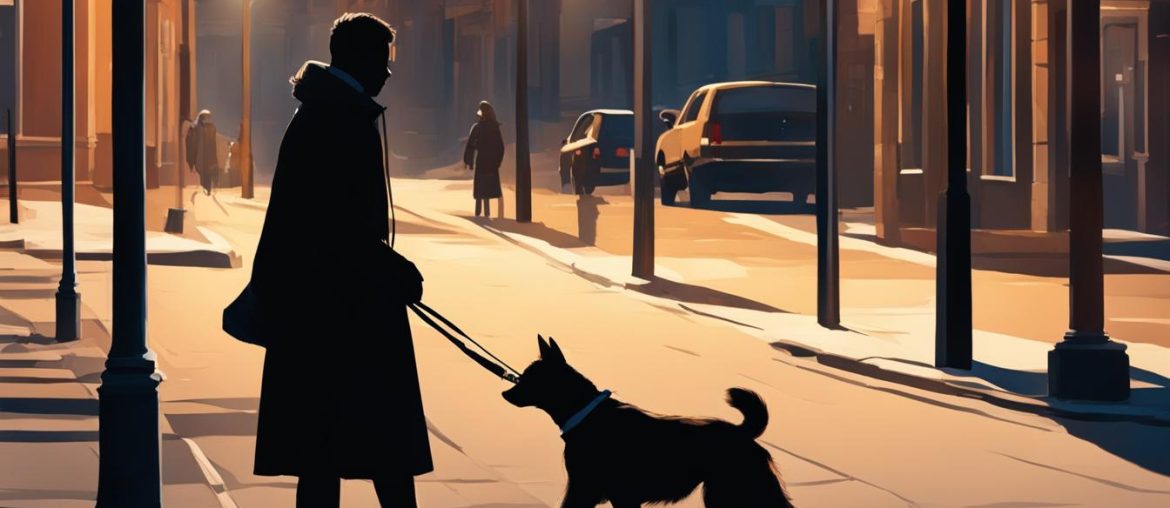Walking your dog at night can be challenging and potentially dangerous. To ensure a safe and enjoyable nighttime stroll with your furry friend, follow these essential tips.
Firstly, prioritize safety by investing in reflective gear such as leashes, collars, and harnesses. These will increase visibility and make you and your dog more visible to motorists, cyclists, and pedestrians.
Secondly, always use proper lighting for navigation. A headlamp or flashlight can help you navigate dark paths and identify potential hazards. Consider using a dog-friendly light attached to your dog’s collar or leash to illuminate the path.
Thirdly, choose safe walking routes by sticking to well-lit streets and familiar paths. Avoid areas with heavy traffic or known for criminal activities. Planning your route in advance will help ensure your safety and allow for an enjoyable nighttime walk.
Additionally, practice leash etiquette by keeping your dog on a leash and using a leash that gives you control over your pup’s movements. This will minimize the risk of running off or getting into dangerous situations.
Furthermore, stay alert and be aware of your surroundings during nighttime walks. Avoid distractions, observe potential hazards, and be cautious of approaching cyclists and vehicles.
Another important tip is to socialize and train your dog in a nighttime environment. Use nighttime walks as an opportunity to socialize your dog cautiously with other friendly dogs, if encountered. Positive nighttime walk experiences can help build your dog’s confidence and make them well-adjusted in different situations.
Dressing appropriately for the weather is also crucial for nighttime walks. Ensure your dog is dressed for colder temperatures with sweaters or jackets if needed, and choose clothing for yourself that provides protection and can be easily adjusted.
Carrying essential supplies such as a collapsible water bowl, portable water, waste bags, and a basic first aid kit is necessary for nighttime walks. These supplies will help keep your dog hydrated, maintain cleanliness, and address any minor injuries that may occur.
Lastly, prioritize your safety and enjoyment by following these tips and taking necessary precautions. With the right mindset and preparedness, nighttime walks can be a rewarding bonding time with your furry companion.
Key Takeaways
- Invest in reflective gear for increased visibility
- Use proper lighting, such as a headlamp or flashlight, for navigation
- Choose safe walking routes that are well-lit and familiar
- Practice leash etiquette to maintain control over your dog
- Stay alert, avoid distractions, and be aware of your surroundings
Invest in Reflective Gear for Visibility
When it comes to walking your dog at night, one of the most important factors to consider is visibility. With limited natural light, please invest in reflective gear to ensure the safety of both you and your furry friend. Reflective leashes, collars, harnesses, and vests are essential tools that increase visibility and make you and your dog more noticeable to motorists, cyclists, and pedestrians.
“Reflective gear is an absolute must-have for nighttime walks,” says dog trainer, Sarah Johnson.
“By using reflective gear, you significantly reduce the risk of accidents and enhance your visibility in low-light conditions. This added visibility not only helps you and your dog stay safe but also provides reassurance to others sharing the same path.”
By incorporating reflective gear into your nighttime walks, you can effectively minimize the chances of accidents and promote a safe and enjoyable experience for both you and your furry companion.

| Reflective Gear | Features |
|---|---|
| Reflective Leashes | Designed with reflective material to enhance visibility |
| Reflective Collars | Equipped with reflective strips for increased visibility |
| Reflective Harnesses | Includes reflective patches for easy visibility |
| Reflective Vests | Highly visible and lightweight for maximum comfort |
Use Proper Lighting for Navigation
When walking your dog at night, I would advise that you prioritize visibility and ensure your safety on dimly lit paths. Using proper lighting can help you navigate effectively and identify potential hazards along the way. Consider incorporating the following lighting options into your nighttime dog walking routine:
1. Headlamp for Dog Walking
Wearing a headlamp provides hands-free illumination and allows you to keep your focus on your dog and the path ahead. Opt for a headlamp with a bright LED light that offers a wide beam angle, ensuring maximum visibility.
2. Flashlight for Dog Walking
A small, handheld flashlight can be a convenient alternative to a headlamp. Choose a flashlight with a strong beam and an adjustable focus for versatility in different lighting conditions.
3. Dog-Friendly Light
Consider attaching a dog-friendly light to your dog’s collar or leash. These lights are designed to be lightweight and compact, ensuring they don’t interfere with your dog’s movements. Dog-friendly lights come in various forms, including clip-on lights, collar lights, and light-up leashes, providing visibility for both you and your furry companion.
By using proper lighting during nighttime dog walks, you can illuminate the path and identify any potential obstacles, ensuring a safer and more enjoyable experience for you and your dog.
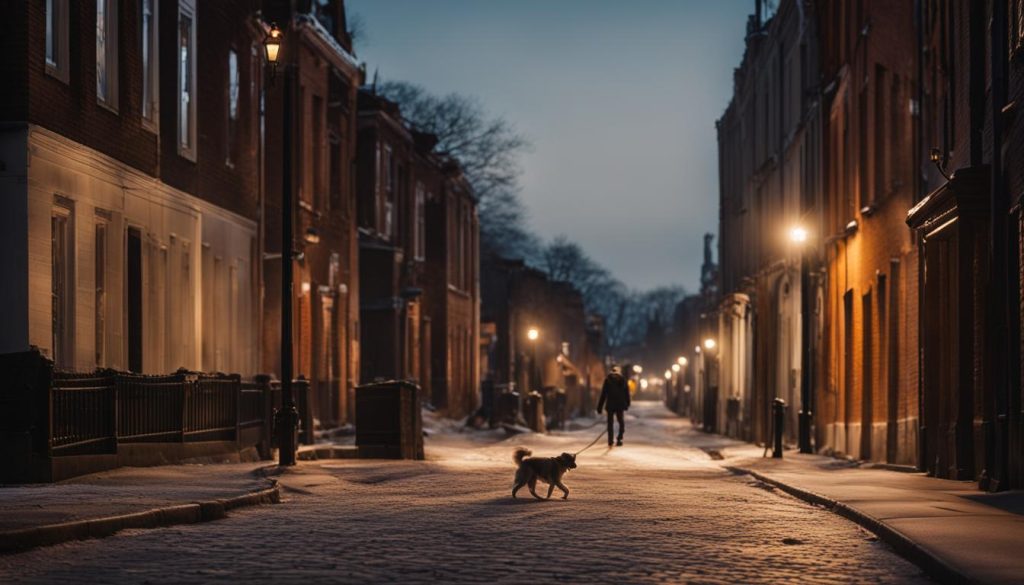
Choose Safe Walking Routes
When it comes to walking your dog at night, one of the key considerations is choosing safe walking routes. Opt for well-lit streets and familiar paths that provide good visibility. Avoid areas with heavy traffic or known for criminal activities to minimize potential risks. By planning your route in advance and sticking to well-known areas, you can ensure a safe and enjoyable nighttime walk.
Good sidewalks are also essential for a safe walking experience. Look for routes that have well-maintained and wide sidewalks, allowing enough space for both you and your dog. This will not only provide a comfortable walking surface but also minimize the chances of accidents or mishaps.
To summarize, choosing safe walking routes involves:
- Selecting well-lit streets and familiar paths
- Avoiding heavy traffic areas and known trouble spots
- Ensuring good sidewalks for a comfortable walk
By following these guidelines, you can have peace of mind while walking your dog at night, knowing that you have chosen the safest routes for you and your furry companion.
| Advantages of Safe Walking Routes | Disadvantages of Unsafe Walking Routes |
|---|---|
|
|
QUOTES:
“Choosing safe walking routes at night is crucial for the well-being of both you and your dog. I recommend that you prioritize visibility and avoid areas with heavy traffic or known for criminal activities. By taking these precautions, you can make your nighttime walks enjoyable and worry-free.”
Overall, the key to safe nighttime dog walks lies in selecting routes that offer good visibility, familiar surroundings, and well-maintained sidewalks. By doing so, you can minimize risks and enjoy the experience of walking your dog at night.
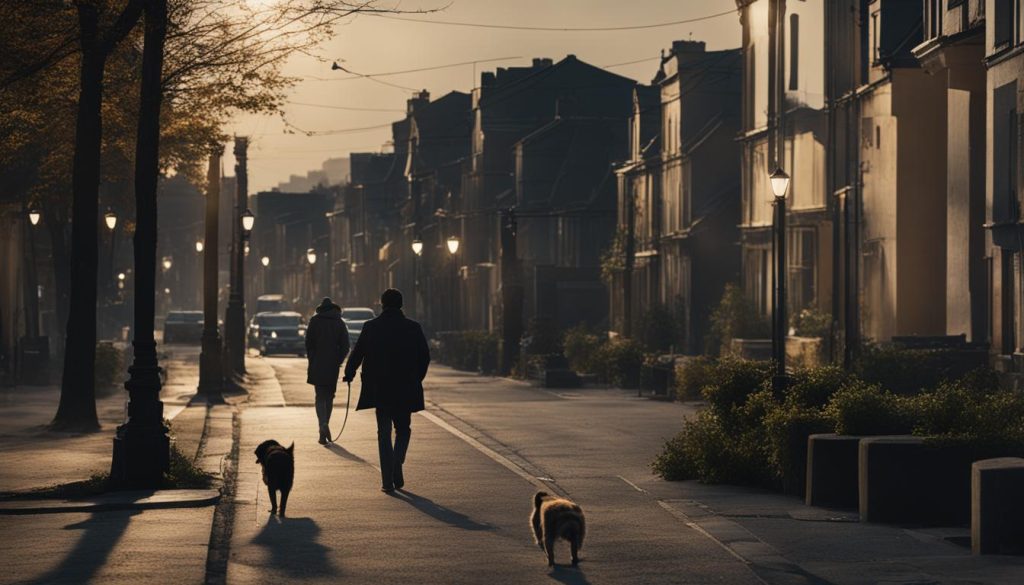
Practice Leash Etiquette for Control
When walking your dog at night, prioritize safety and maintain control over your furry companion. Proper leash etiquette is crucial to prevent dangerous situations and ensure a pleasant walking experience. By following these tips, you can navigate nighttime walks with confidence.
Leash Training
Before venturing out for a nighttime walk, I would advise that you ensure that your dog is well-leash trained. This means they should understand basic commands such as “heel” and “stay” and respond appropriately to your cues. Leash training helps you maintain control over your dog and prevents them from pulling or darting off unexpectedly.
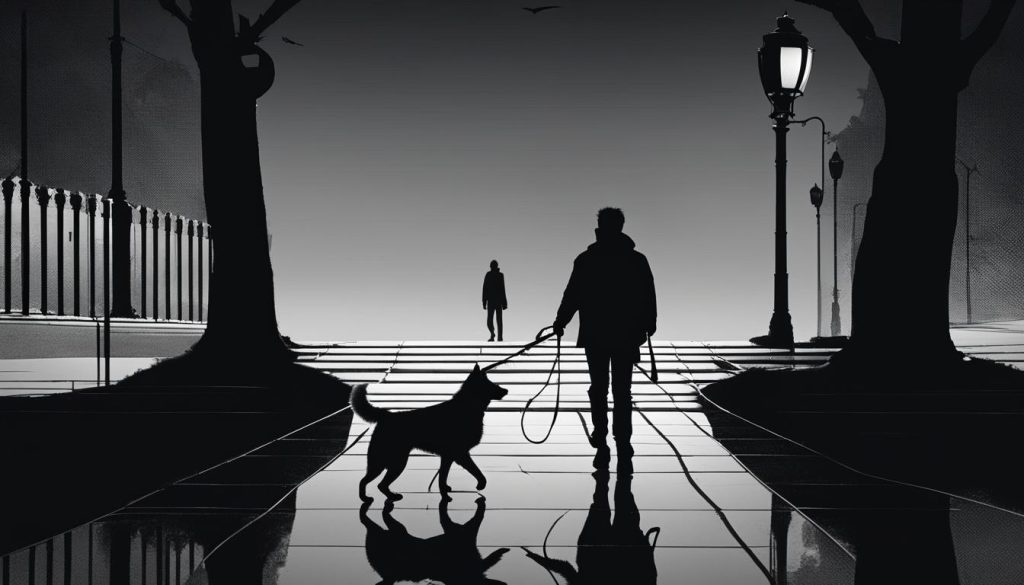
Keep Your Dog on Leash
Regardless of how well-trained your dog is, please keep them on a leash during nighttime walks. This allows you to have better control over their movements and prevents them from chasing after distractions or running into traffic. Keeping your dog on a leash also ensures they stay safe and minimizes the risk of encountering other animals or people that may not be friendly.
Maintain a Good Leash Condition
Regularly check the condition of your dog’s leash to ensure it’s in good working order. Look for any signs of wear or damage, such as frayed edges or weak spots. Replace the leash if necessary to prevent any accidents or breakages during your nighttime walks.
Prevent Dangerous Situations
By practicing leash etiquette and keeping your dog on a leash, you can prevent dangerous situations from arising. This includes avoiding potential conflicts with aggressive dogs, preventing your dog from wandering into unsafe areas, and minimizing the risk of them getting injured or lost. Try to always be alert and aware of your surroundings to respond quickly and appropriately if any potential dangers arise.

| Benefits of practicing leash etiquette for walking dogs at night: |
|---|
| Enhanced control over your dog’s movements |
| Prevention of potential conflicts with other animals |
| Reduced risk of accidents and injuries |
| Minimized chances of your dog getting lost |
Stay Alert and Be Aware of Surroundings
When walking your dog at night, please stay alert and be aware of your surroundings. By maintaining a heightened sense of awareness, you can help prevent potential accidents and ensure the safety of both you and your furry companion.
Avoid distractions such as listening to loud music or taking phone calls while walking your dog at night. These distractions can impair your ability to notice potential hazards and react quickly. Instead, focus on your surroundings and be mindful of any potential dangers.
Observe the path ahead and look out for any potential hazards such as potholes, uneven surfaces, or obstacles that may not be easily visible in the dark. This will help you navigate the terrain safely and prevent any accidents or injuries.
“Being cautious of approaching cyclists and vehicles is also essential when walking your dog at night. Give cyclists and vehicles the right of way and be mindful of their presence to avoid any potential collisions.”
By staying alert and being aware of your surroundings, you can ensure a safe and enjoyable nighttime walk with your dog. Try to avoid distractions, observe potential hazards, and be cautious of approaching cyclists and vehicles. With these precautions in mind, you can confidently navigate the night and create lasting memories with your furry friend.
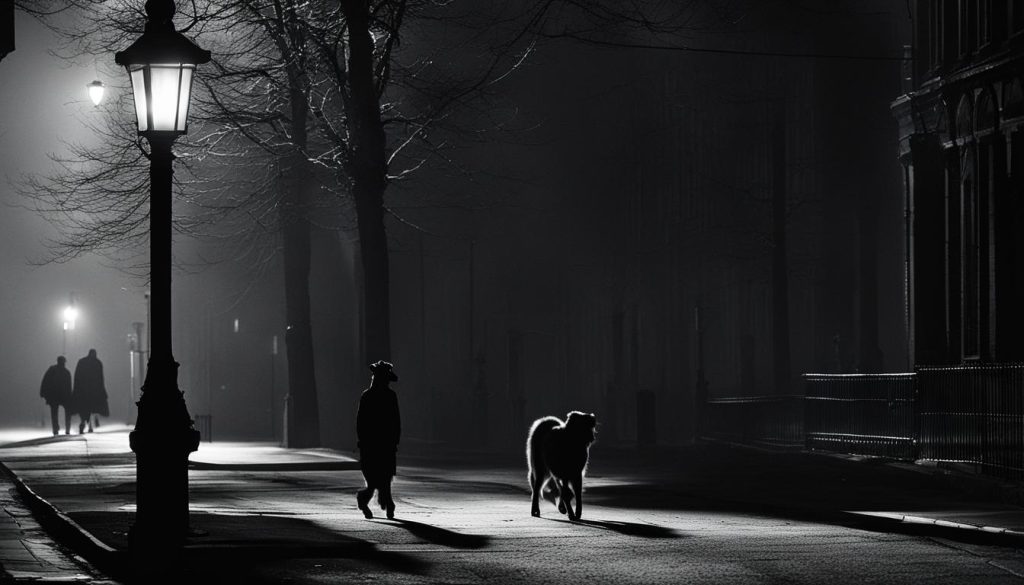
Socialize and Train Your Dog in Nighttime Environment
When it comes to nighttime walks, it’s not just about ensuring your dog’s safety; it’s also an opportunity to socialize and train your furry friend in a different environment. With fewer encounters with other dogs and people during nighttime walks, it can be less overwhelming for shy or easily overwhelmed dogs. By cautiously socializing your dog with other friendly dogs you may encounter, you can create positive experiences and help build your dog’s confidence.
Nighttime walks provide a unique setting for training your dog to be well-adjusted in various situations. It allows them to experience different sounds, smells, and sights, helping them become more confident and adaptable. Use these walks as an opportunity to reinforce obedience commands and improve their leash manners. By practicing basic training techniques in a nighttime environment, you can enhance their responsiveness and create a well-rounded companion.

Try to take it slow and assess your dog’s comfort level. Gradually increase the duration and intensity of nighttime walks as your dog becomes more confident and relaxed. Pay attention to their body language and provide positive reinforcement such as treats or praise to reward good behavior. I recommend that you create a calm and enjoyable atmosphere during nighttime walks, allowing your dog to feel safe and secure.
Tips for Socializing and Training Your Dog at Night:
- Start with short nighttime walks to help your dog become familiar with the environment.
- Expose your dog to different sounds and sights during nighttime walks to desensitize them to potential stressors.
- Encourage positive interactions with other dogs by allowing controlled and supervised meet-ups.
- Use treats and rewards to reinforce good behavior and obedience commands during nighttime walks.
- Keep leash training consistent and reward your dog for walking politely beside you.
By socializing and training your dog in a nighttime environment, you can help them become confident, well-adjusted, and obedient companions. Try to prioritize their safety during nighttime walks and enjoy the unique experience of exploring the world after dark with your furry friend.
Dress Appropriately for the Weather
When taking your furry friend for a nighttime walk, please dress appropriately for the weather to ensure both your comfort and your dog’s well-being. As the temperatures drop during colder months, provide your dog with the necessary clothing to keep them warm. Consider investing in sweaters or jackets specifically designed for dogs to provide an extra layer of insulation.
Adjusting your own clothing is equally important. Layering is key to staying warm in chilly temperatures, so opt for lightweight, moisture-wicking base layers followed by a insulating layer and a windproof outer layer. This will help regulate your body temperature and protect you from the elements. Don’t forget to wear a hat, gloves, and warm socks to keep extremities cozy.
Similarly, extreme weather conditions like storms, heavy rain, or extreme heat demand extra precaution. In severe weather, it may be best to avoid taking your dog out for a walk altogether. Their well-being should always be the top priority. If venturing out is unavoidable, make sure to adjust your clothing accordingly, wearing waterproof gear for rainy days or light, breathable clothing in hot weather.
| Weather Condition | Appropriate Clothing |
|---|---|
| Colder Temperatures | Sweaters or jackets for dogs, layered clothing for humans |
| Extreme Heat | Light, breathable clothing, hats, and sunscreen |
| Heavy Rain | Waterproof jackets and footwear, umbrellas |
| Snowy or Icy Conditions | Insulated and waterproof boots or shoes, warm socks |
To put it simply, dressing appropriately for the weather will help ensure a comfortable and enjoyable nighttime walk for both you and your four-legged companion.
Carry Essential Supplies for Nighttime Walks
When embarking on a nighttime walk with your dog, please be prepared and carry essential supplies to ensure the safety and comfort of both you and your furry companion. Here are some essential items to include in your nighttime dog walking kit:
- Collapsible water bowl: Staying hydrated is important for both you and your dog during walks, especially on warmer nights. A collapsible water bowl is convenient and allows you to provide water for your dog whenever needed.
- Portable water: Along with a water bowl, remember to carry an adequate supply of water for your dog. Portable water bottles or water pouches designed for pets are handy and easy to carry.
- Waste bags: Responsible dog ownership includes cleaning up after your pet, even during nighttime walks. Always have waste bags with you to promptly and properly dispose of your dog’s waste in designated areas.
- Basic first aid kit: Accidents can happen at any time, so I would advise that you have a basic first aid kit with you. Include items such as antiseptics, bandages, tweezers, and wipes to address any minor injuries that may occur during the walk.
By carrying these essential supplies, you can be well-prepared for any situation that may arise during your nighttime dog walks. It’s always better to have them on hand and not need them than to find yourself in a situation where they would have been beneficial but are unavailable.
| Essential Supplies for Nighttime Dog Walks |
|---|
| Collapsible water bowl |
| Portable water |
| Waste bags |
| Basic first aid kit |
To put it simply, being prepared ensures not only your dog’s safety and well-being but also your peace of mind during nighttime walks. It’s always better to err on the side of caution and have these essential supplies readily available.

Prioritize Your Safety and Enjoyment
When embarking on nighttime dog walks, please prioritize safety to ensure a pleasant and worry-free experience. By following a few simple precautions, you can enjoy the peaceful ambience while keeping yourself and your furry companion safe.
Stay Alert and Be Prepared
Being aware of your surroundings is essential when walking your dog at night. Avoid distractions such as using your phone or wearing headphones, as they can hinder your ability to react to potential hazards. Instead, focus on observing your surroundings and any potential obstacles that may be difficult to see in the dark.
Use Reflective Gear and Proper Lighting
Enhancing visibility is key to staying safe during nighttime walks. Invest in reflective gear for both you and your dog, such as collars, leashes, and vests, to make yourselves more visible to passing drivers and pedestrians. Additionally, carry a reliable light source, such as a flashlight or headlamp, to illuminate your path and ensure you can react quickly to any sudden risks.
Choose Safe Walking Routes
Selecting safe and well-lit routes is an important consideration for nighttime walks. Stick to familiar paths and streets that are known to be safe, avoiding areas that may pose potential risks. By planning your route in advance, you can ensure a secure and enjoyable walk for you and your canine companion.
| Nighttime Walking Precautions | Enjoyable Nighttime Dog Walks |
|---|---|
| Stay alert and be aware of your surroundings. | Embrace the peaceful ambience. |
| Use reflective gear for enhanced visibility. | Enjoy the serenity of a nighttime stroll. |
| Carry a reliable light source for navigation. | Bond with your furry friend under the starry sky. |
| Choose safe walking routes. | Discover new nighttime adventures. |
By prioritizing safety and following these nighttime walking precautions, you can create an environment that allows for enjoyable and worry-free walks with your four-legged friend. Try to stay alert, be prepared, and embrace the unique experience of exploring the world after dark.
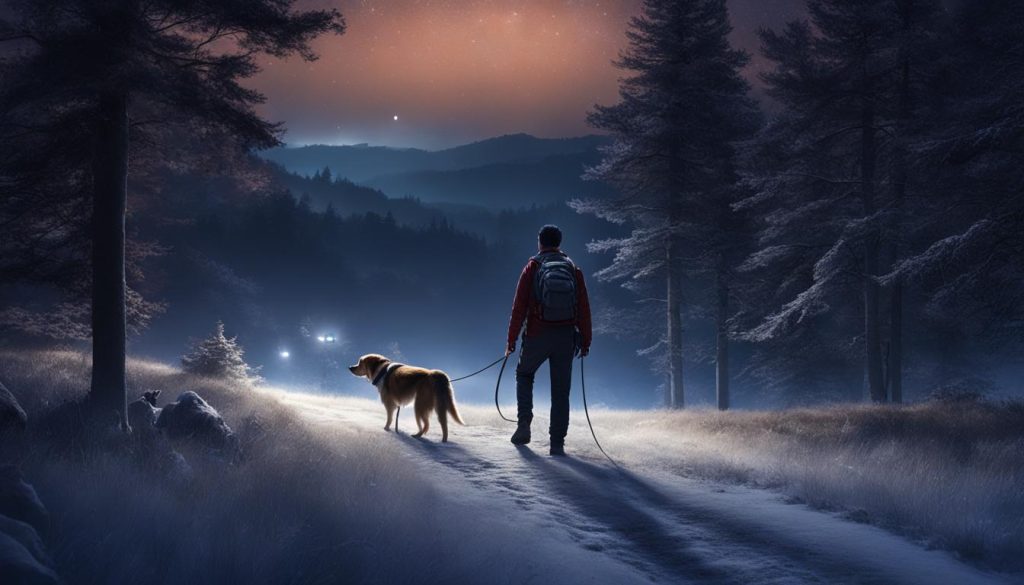
Find What Works Best for You and Your Dog
When it comes to nighttime walks with your dog, find a routine that works best for both you and your furry friend. Every dog is unique, and what works for one may not work for another. By customizing your walking routine and adapting it to suit your individual needs, you can ensure that both you and your dog have an enjoyable and safe experience.
First, consider your own preferences and schedule. Are you a morning person or do you prefer evening walks? Finding a time that works best for you will make it easier to stick to your routine and ensure that you’re fully present and focused during your walks.
Next, think about your dog’s needs and preferences. Some dogs may have more energy in the mornings, while others may be more active in the evenings. Take into account their exercise requirements and try to structure your walking routine around their natural energy levels. This will help keep them engaged and prevent boredom or restlessness during walks.
Additionally, pay attention to the specific needs of your dog’s breed or size. Some breeds may require longer walks or more mental stimulation, while others may be more prone to overheating or cold. Adjust the duration and intensity of your walks accordingly to ensure your dog’s comfort and well-being.
To put it simply, finding the best nighttime walking routine is a process of trial and error. Be open to experimenting with different routes, distances, and activities to see how your dog responds. Observe their behavior and adjust your routine as needed to accommodate their individual preferences and needs. With time, you’ll be able to establish a nighttime walking routine that both you and your dog look forward to.
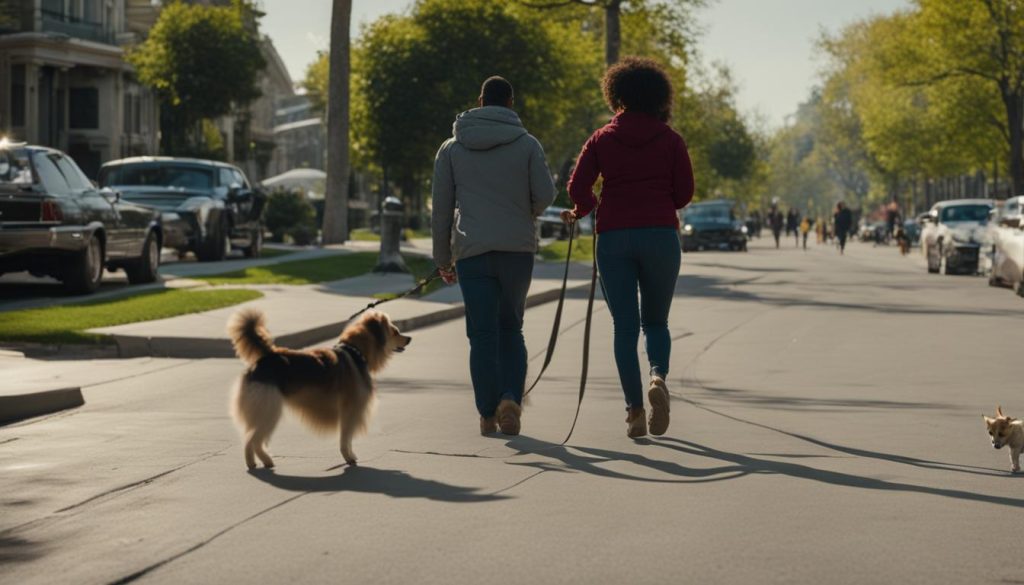
Table: Tips for Customizing Your Nighttime Walking Routine
| Considerations | Tips |
|---|---|
| Time of day | Choose a time that works best for you and allows for focused and enjoyable walks. |
| Dog’s energy levels | Structure your routine around your dog’s natural energy patterns for a more engaging experience. |
| Breed or size | Take into account your dog’s specific needs and adjust the duration and intensity of walks accordingly. |
| Preferences and behavior | Observe how your dog responds to different routes, distances, and activities, and adjust your routine to suit their preferences. |
Final Thoughts
Walking your dog at night can be a wonderful experience, providing both exercise and bonding time. By following these essential nighttime dog walking tips, you can ensure safe and enjoyable nighttime strolls with your furry companion.
Prioritize visibility by investing in reflective gear such as leashes, collars, and harnesses. This will make you and your dog more visible to others, minimizing the risk of accidents. Additionally, use proper lighting with a headlamp or flashlight to navigate dark paths and identify potential hazards.
Choose safe walking routes that are well-lit and well-known to you. Avoid areas with heavy traffic or criminal activities. Practicing leash etiquette will give you control over your dog’s movements and prevent dangerous situations. Stay alert, be aware of your surroundings, and avoid distractions to effectively deal with potential hazards.
Try to socialize and train your dog during nighttime walks, providing positive experiences and building confidence. Dress appropriately for the weather, ensuring your dog’s comfort and adjusting your clothing as needed. Carry essential supplies such as a collapsible water bowl, waste bags, and a basic first aid kit to address any minor injuries.
Ultimately, prioritize your safety and enjoyment during nighttime walks. Experiment with different routines to find what works best for you and your dog, customizing the walking routine to accommodate individual preferences. With proper preparation and attention, nighttime walks can become a cherished part of your daily routine, allowing for exercise, mental stimulation, and quality time with your beloved canine companion.
FAQ
Why is visibility important when walking my dog at night?
Visibility is important when walking your dog at night to prevent accidents and keep you and your dog safe. Investing in reflective gear such as leashes, collars, and harnesses can make both you and your dog more visible to motorists, cyclists, and pedestrians.
What kind of lighting should I use when walking my dog at night?
I highly suggest that you have a reliable light source when walking your dog at night. Consider using a headlamp or flashlight to help you navigate dark paths and identify potential hazards. You can also use a dog-friendly light attached to your dog’s collar or leash to illuminate the path.
How can I choose safe walking routes for nighttime walks?
When walking your dog at night, stick to familiar streets and paths that are well-lit and well-maintained. Avoid areas with heavy traffic or known for criminal activities. Planning your route in advance will help ensure your safety and allow for an enjoyable nighttime walk.
Why is leash etiquette important for nighttime walks?
Keeping your dog on a leash is essential for nighttime walks. Practice leash etiquette by ensuring your dog is well-leash trained and always stays on a leash. Use a leash that gives you control over your pup’s movements to minimize the risk of running off or getting into dangerous situations.
How can I stay alert and be aware of my surroundings during nighttime walks?
Staying alert and being aware of your surroundings is crucial when walking your dog at night. Avoid distractions such as listening to loud music or taking phone calls. Keep your eyes open for potential hazards like potholes or obstacles that may not be easily visible in the dark. Be cautious of approaching cyclists and vehicles and give them the right of way.
How can nighttime walks help with socializing and training my dog?
Nighttime walks provide a unique opportunity to socialize and train your dog in a different environment. With fewer encounters with other dogs and people, nighttime walks can be less overwhelming for shy or easily overwhelmed dogs. Use these walks as an opportunity to socialize your dog cautiously with other friendly dogs to build their confidence and make them well-adjusted in various situations.
How should I dress my dog and myself for nighttime walks?
Dress your dog appropriately for colder temperatures with sweaters or jackets if needed. For yourself, choose clothing that provides protection and can be easily adjusted. Be cautious of extreme weather conditions such as storms, heavy rain, or extreme heat, and adjust your walking routine accordingly to keep your dog safe and comfortable.
What essential supplies should I carry for nighttime walks?
I recommend that you be prepared and carry essential supplies for nighttime walks. Bring a collapsible water bowl and portable water to keep your dog hydrated. Pack waste bags to clean up after your dog in public areas, demonstrating responsible pet ownership. Additionally, carry a basic first aid kit with items such as antiseptics, bandages, tweezers, and wipes to address any minor injuries that may occur during the nighttime walk.
How can I prioritize safety and enjoyment during nighttime walks?
Prioritize safety during nighttime walks by staying alert, using proper lighting, choosing safe walking routes, and practicing leash etiquette. These measures will ensure both you and your dog’s safety. Additionally, customize your walking routine to accommodate individual preferences and needs, ensuring that both you and your dog enjoy the nighttime ambience while staying safe.
How can I find the best nighttime walking routine for me and my dog?
Each dog and owner have unique needs and preferences when it comes to nighttime walks. Experiment with different strategies and routines to find what works best for you and your dog. Customize your walking routine to accommodate individual preferences and needs, ensuring that both you and your dog enjoy the nighttime ambience while staying safe.


